
3 Strategies for Water-Wise Development in Ethiopia
The rain has picked up in Ethiopia in recent weeks, but experts sayit’s not enough. Three consecutive seasons of below-average rainfall have left Ethiopia’s regions vulnerable to crop failures, livestock losses and food and water insecurity — and experts arecallingfor the government and humanitarian partners to prepare to scale up assistance.
This recent drought is not an anomaly. Despite being known as the “Water Tower of Africa,” home to the headwaters of the Blue Nile and numerous freshwater lakes, Ethiopia’s water resources prove a significant challenge for the growing country’s prosperity. The country is naturally exposed to highly variable rainfall, a challenge that is compounded by growing water demands,climate changeandwatershed degradation.
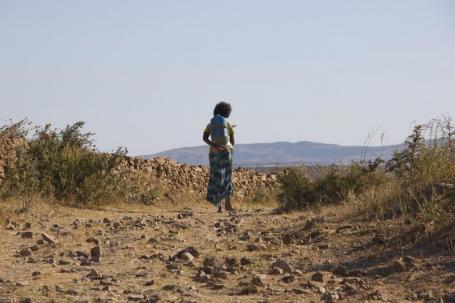
Access to safe and reliablewater is essentialto human health and well-being, as well as economic growth. Ensuring sustainable water use for development is a challenge that requires careful consideration and planning across sectors. Whether the goal is to increase access to water and sanitation or bolster rural livelihoods and economic performance through agriculture and industry, failing to consider water — both current and future supplies — can put development gains and infrastructure investments at risk.
The data required to make water-wise development decisions is often inadequate or inaccessible — due to obstacles such as limited data collection, database issues or lack of resources. This is the challenge we had in mind when WRI developeda baseline water risk assessment modelfor mapping, monitoring and scenario-planning of water risks in Ethiopia, analyzing water use by sector in relation to available water resources.
Results from the model indicate severe water scarcity in many parts of Ethiopia, highlighting the need to develop strategies to balance water resources and growing water demand to ensure sustainable development.
Here are three strategies for water-wise development in Ethiopia:
1. Create Balance Between Water Withdrawals and Available Supply.
Ethiopian water resources are unevenly distributed. Basins in the western part of the country account for approximately70%of its water resources. Conversely, substantial volume of the water demand, particularly for irrigation, exists in the eastern portion, indicating a heavy imbalance that leads tosevere water stress— which poses serious threats to human lives, livelihoods and economic stability.

For example, while industrial water withdrawal accounts for less than 2% of Ethiopia’s total water withdrawal, 74% of the industrial water withdrawal is concentrated in subbasins experiencing high and extremely high water stress. Results indicate that the Awash Basin, which is the most water stressed basin in Ethiopia, accounts for approximately 55% of the total industrial water withdrawal.
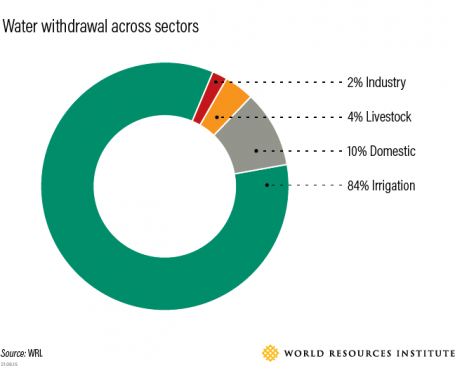
Nearly 25% (27 million) of Ethiopia’s population lives in areas of high water stress, threatening the country’s Sustainable Development Goal to achieve water, sanitation and hygiene (WASH) by2030. Six of the 10 regional capitals are located in either high or extremely high water stress areas. And rapidurbanization ratesin Ethiopian cities such asAddis Ababaand surrounding communities further jeopardizeurban water resilience.
A high concentration of competing water demands — particularly in areas with relatively low water resources — creates an imbalance that impedes sustainable socioeconomic growth and improved livelihoods. Correcting this imbalance will involve strategies that help store and conserve water and improve water use efficiency and productivity. These responses would reduce stress — or competition — for limited water supplies, while meeting demands from water users.
Water use efficiency improvements, for example, can be made in every sector and subsector of industry, domestic water use and agriculture. Improvinglow water use efficiency— for example, water lost before use — is particularly important inirrigation, which accounts for 84% of total water demand in Ethiopia.
2. Build Water Resilience Strategies.
Ethiopia has made progress inimproving resilience, but vulnerability to extreme weather events is a continuing challenge. Significant parts of Ethiopia experience high seasonal and inter-annual variability, which are expected tointensifybecause of climate change.
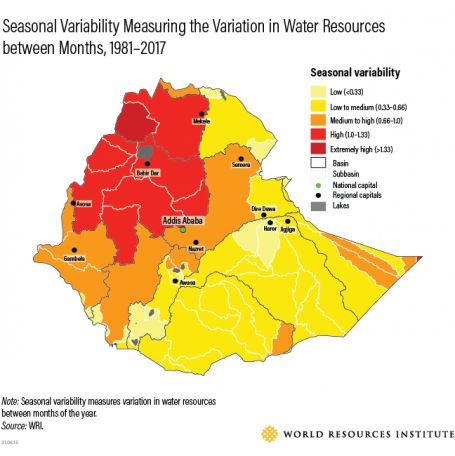
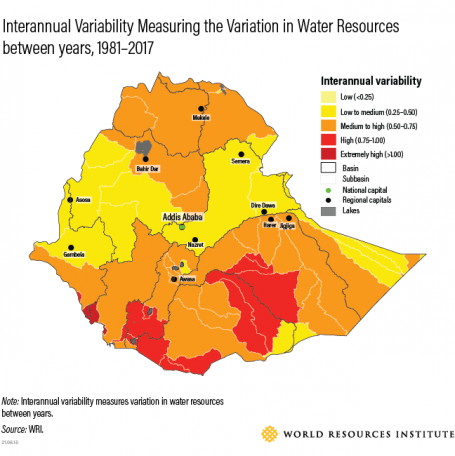
Monthly water stress, where total water demand accounts for more than 80% of the available water resources, is also significant in several subbasins.

Given thelinksbetween climate change, frequent droughts, impact on livelihoods and the high cost of emergency assistance, proactive water resilience strategies are critical. These are strategies that seek to ensure the long-term availability and performance of water supply systems and enhance people’s capacity to endure, overcome and recover from water-related shocks (such as drought and floods).
The impacts of climate change andsocioeconomic insecurityare most pronounced in the water sector. Exploring hard measures — such as improving water storage and transportation infrastructure — as well as soft measures — like water trading, crisis response mechanisms, crop insurance and social safety nets — can strengthen resilience and help combat water-related shocks and stresses.
3. Plan for Transformation Across Sectors.
Since 2000, Ethiopia has consistently improved crop production, with a fourfold increase in cereals that reached approximately26 million metric tons of cerealsin 2017.
However, much of the increase in production in the past decade has been due to increases in areacultivated. With little uncultivated land left in the Ethiopian highlands — and the government eyeing further expansion in irrigation to improve food security and complement its strategy ofagriculture-led industrialization— attaining balance between water availability and demand is critical to achieve development and the SDG goals.
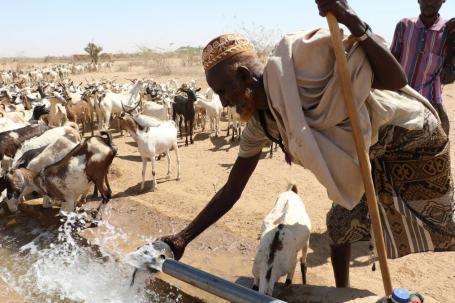
But improving water use efficiency and employing resilience strategies alone may be insufficient to reduce threats to development objectives. Therefore, development planners should identify long-term strategic shifts in economic activities, where necessary.
Fundamental economic and sectoral transformations may ultimately be necessary to respond to water stress and theimpactsof climate change. In the agricultural sector, for example,transformativeadaptations can include shifting the geographical location of crops to more suitable areas, improving agricultural input to sustainably increase yield. This includes using advanced technology for optimization or shifting from high water consumptive crops such as sugarcane and cotton to less water intensive crops and varieties.
Ethiopia’s sustainable socioeconomic growth will depend on resilient and transformative approaches to effectively balance growing water demands and available water resources. Strategic and water-wise development can help reduce crisis and conflict, improve livelihoods, tackle environmental challenges, and place Ethiopia on the path to further economic gains in the coming decades — even amid climate uncertainty.